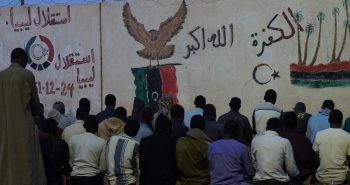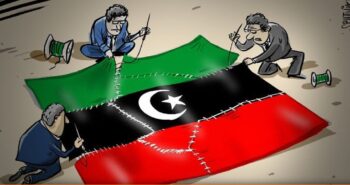Wolfram Lacher & Jérôme Tubiana

Migrant extortion business
Europe’s policies are not the fundamental reason why migrants are violently preyed upon in Libya: exploitation was built into the country’s migration governance during the Gaddafi era, when Libya hosted well over a million migrant labourers — among them hundreds of thousands of sub-Saharans who lacked any regular status and were already exposed to arbitrary detention and deportation. The big bang of today’s extortion racket came with the collapse of central authority, along with the Gaddafi regime itself, in 2011.
Thereafter, armed groups forming across the country could smuggle or ransom migrants in their own sphere of influence — often selling them protection from their own threats. Whether they acted as units of the fractured state’s security forces or as non-state criminal gangs initially made little difference.
European policies did, however, shape the business models used by Libya’s migration profiteers today. They incentivised extortionists to operate within state security institutions, and to profit primarily from preventing crossings rather than enabling them. Europeans — beginning with Italy — thereby helped create a now well-entrenched system of exploitation by state-sanctioned forces.
The foundational moment came in July 2017, a few months after Italy and the government in Tripoli signed an agreement to cooperate ‘in the fight against illegal migration’. The year before, Libya had become the most important route for migrants and refugees to Europe, and 2017 was on track to become another record year for arrivals in Italy. But that July, the numbers suddenly dropped.
This was not due to an increase in interceptions by the LCG, which was just then starting to receive boats and training from the EU and Italy. (They have since supplied over 30 boats to the LCG). Rather, it was because militia leaders in western Libyan coastal cities suddenly began preventing departures. Tripoli and Italian officials had reached out to them, promising them legitimacy as units of state security forces, and raising the threat of sanctions or prosecution if they kept smuggling migrants.
From then on, counter-migration became an attractive business model for Libyan militias. It offered official status, salaries and access to state budgets such as DCIM funds. Libyan state funds for food and cleaning of detention centres could be embezzled in myriad ways, as could the aid provided by UN agencies funded by the EU. Detainees could be rented out as forced labour and extorted in exchange for their release.
In fact, many militia leaders simultaneously engaged in counter-migration and migrant smuggling. In Al-Maya as elsewhere, they adapted their business model to shifting political conditions. According to migrants who made it to Europe, the best smugglers are LCG members — who run no risk of being intercepted. Recently, and increasingly, Libyan military vessels have been seen dropping migrants outside the Libyan Search and Rescue zone, in front of European vessels.
Crucially, counter-migration turned militia leaders into interlocutors for international actors. Coastguard and detention centre commanders received Italian intelligence operatives, IOM and UNHCR delegations, as well as foreign embassies seeking to repatriate their detained citizens. The heads of the DCIM and their superiors in the interior ministry were courted by European ambassadors.
Boosted by the money and foreign connections they accumulated through counter-migration, militia leaders gradually took over state institutions. In 2021 the commander of Tripoli’s notorious Tariq al-Sikka detention centre, Mohammed al-Khoja, became the head of the DCIM. Emad Trabelsi, whose group had controlled the similarly ill-reputed Al-Mabani detention centre in the city, was appointed interior minister the following year. Trabelsi picked two of his lieutenants as, respectively, Khoja’s deputy and the head of a new border guard. Trabelsi’s associates would work together on locking up migrants deported by the Tunisian authorities in Al-Assa, then moving them to a detention centre in the hinterland south of Tripoli.
The Buzribas also rose through the ranks: Essam Buzriba has been interior minister in the eastern, parallel government since 2022; in Tripoli, the Presidency Council promoted his brother Hassan to head the SSA in June 2025, despite his open enmity towards prime minister Abdul Hamid al-Dbeibeh. Networks that owed their rise to the migrants business now run it from the top echelons of the state.
How to amass capital
These figures’ ascent reflected a broader conquest of the state by militia leaders. Counter-migration was not their only path to accumulating capital and building foreign connections. They could make even more money by infiltrating the financial networks through which Libya’s oil revenues were channelled into imports, public contracts, subsidies and the like. But in the domain of counter-migration, they benefited from an incentive structure created by EU policies. After all, LCG interceptions supported by the EU formed the main supply of captives for the detention centres — the EU’s nominal opposition to arbitrary detention in Libya notwithstanding.
Critics of the EU’s policies often disparage its Libyan partners as mere militias, referring to the ‘so-called Libyan coastguard’. This may have been a valid criticism when the current policies were devised in 2017. Today, it misses the point: Libya’s militias have become the state. In the process, that state has developed vested interests in the continuation of the extortion business — interests that EU policies have helped to create.
On a visit of European ministers to Tripoli this July, Dbeibeh and Trabelsi pitched a grand plan to massively step up deportations of migrants and refugees.
The scheme is wholly unrealistic. The Dbeibeh government has little effective control outside Tripoli, and deportations are costly. But Dbeibeh is fighting for political survival and is seeking to mobilise European support for his government by demonstrating his usefulness. In the past, Europeans would lobby their Libyan counterparts, for whom migration was the lowest priority. But with counter-migration networks having risen to the top of the agenda, senior Libyan officials now bargain over the price for their cooperation.
Dbeibeh is competing for European support with Khalifa Haftar and his sons, whose Libyan Arab Armed Forces control three quarters of Libya’s territory. The Haftars offer the clearest example for how Europe’s obsession with curbing arrivals has led it to legitimising Libyan warlords.
Before 2022, eastern Libya had not been a point of departure for migrant boats, as western Libya is far closer to Italy. But that year, thousands of people suddenly started arriving in Italy from eastern Libya in large fishing vessels. Many had flown into Benghazi airport.
Alarmed, prime minister Giorgia Meloni received Haftar in Rome in May 2023 — the first time Italy had bestowed that honour upon Haftar since his defeat in Tripoli in 2020. Shortly afterwards, the boats from eastern Libya stopped coming.
Since then, Italian officials have regularly met Haftar’s sons, and Italy has started training his troops. The Haftars have demonstrated that they can turn the tap on and off. This year, they have allowed a surge of crossings to Crete, prompting similarly panicked visits by Greek ministers. Athens has since offered to train Haftar’s coastguard, but Haftar is still asking for more.
In July a delegation including ministers from Italy, Greece and Malta as well as EU migration commissioner Magnus Brunner were made to wait at Benghazi airport, then ejected without their scheduled audience with Haftar, who had demanded that they also meet with representatives of his parallel government. Both Brunner and senior Italian officials have repeatedly warned that Russia may ‘weaponise’ migrant departures from Libya against Europe — claims for which there is no evidence to date. There is however ample evidence that Haftar is using migration flows to blackmail Europeans, who seem only too willing to play his game.
In March this year, a campaign spread on Libyan social networks: ‘No to the settlement of Africans in Libya! No to Italy’s plan! Together, let’s drive Africans from Libya! Demonstrate this Friday!’ Pundits and Facebook posts accused the Dbeibeh government of colluding with Italy and other foreign powers in a sinister plan to permanently settle migrants in Libya, forever altering the country’s social fabric.
Political circles opposed to Dbeibeh had launched the campaign, seeking to leverage widespread xenophobia against the government. Only a few dozen people answered their call to take to the streets, but the government panicked. ‘We were worried this could cause pogroms, a bloodbath,’ one of Dbeibeh’s ministers said. He may have been only slightly exaggerating. Many vividly remember the anti-migrant riots of 2000, in which at least 130 sub-Saharan Africans and 16 Libyans were killed.
Trying to seize the initiative, Trabelsi ordered haphazard roundups of migrant workers, promised large-scale deportations, and summoned European ambassadors to tell them that Libya would never accept the settlement of migrants. Meanwhile, the domestic intelligence service shuttered the offices of international NGOs working on improving the situation of migrants and interrogated their Libyan employees. It then publicly accused these NGOs and the UNHCR of having a secret EU plan to permanently settle migrants in Libya.
The cessation of medical care provided by NGOs — some of which were acting on behalf of UN agencies — caused the deaths of several migrants.
The plot may seem familiar: as in neighbouring Tunisia, politicians and security agencies invoke a great replacement theory to present themselves as the guardians of national purity.
Yet in this case, the instrumentalisation of xenophobia by cynical politicians is just part of the story. Suspicions of foreign conspiracies are deep-seated in Libya, including among senior officials. Fear of demographic change is similarly widespread, and not only an expression of racism: naturalising foreigners would dilute the share of oil revenues available to Libyan citizens in the form of public sector salaries and subsidies.
Is Libya really the victim?
Allegations of a European conspiracy to alter Libyan society have long been part of mainstream public discourse on migration. Officials, among them Trabelsi and Dbeibeh, have repeatedly alluded to such claims, which are rooted in the almost universal view that Libya is above all the victim of transit migration to Europe. That discourse obscures the fact that the overwhelming majority of migrants — in particular those from neighbouring Niger and Chad — come to Libya to work rather than travel on to Europe, and the Libyan economy depends on a large migrant labour force.
It also ignores the EU’s funding for so-called ‘voluntary humanitarian returns’ through which the IOM has repatriated over 100,000 migrants from Libya since 2015 — far more than the Libyan authorities could achieve, and infinitely more than the UNHCR resettlement programmes to a handful of ‘safe’ countries in Europe and North America still willing to welcome refugees. (Tellingly, the IOM was spared by the domestic intelligence services’ accusations of collusion in malign European designs).
Yet EU policies have also unwittingly helped to lend such conspiracy theories a degree of plausibility.
The EU does, after all, focus on blocking migrants in Libya. Moreover, through the IOM and other organisations, the EU has also long sponsored efforts to improve the conditions of migrants in Libya, in detention centres but also through projects supporting service delivery in localities, or (unsuccessful) attempts to regularise the legal status of migrant workers.
The reasoning behind such initiatives is sensible: migrants coming to work in Libya may be forced to move on to Europe by hardship and exploitation; migrants seeking to reach Europe may choose to stay in Libya if they find work and safety there. But in a society that rejects the notion of Libya as a destination country, such efforts are easily seen as pernicious.
Libyans’ fears of Western conspiracies are certainly not assuaged by recurrent media reports that the Trump administration is looking towards Libya as a destination to which both to deport third-country nationals and to transfer hundreds of thousands of Palestinians from Gaza.
Vying for US backing, both Dbeibeh and the Haftars have reportedly signalled their openness to such plans. Whether they would actually cooperate in implementing them is uncertain — that they could weather the public backlash this would trigger is unlikely. Still, even their willingness to entertain such ideas shows how ruthlessly they pursue their quest for power.
This is also true of their cooperation with Europe which, by trapping migrants in Libya and turning Libyan forces into EU proxies, clearly runs counter to the national interest and pride as most Libyans would define them. The prevalent perception is that European policies are ‘more concerned with Europe’s interests than they are with Libya’s stability and security’
For now, Europe is satisfied with using Libya as a legal grey zone, where the lack of refugee laws conforming to international standards allows for counter-migration measures that would be illegal elsewhere. But in the long run, the EU is empowering forces that are no longer content to ransom migrants, but have their eyes set on extorting European governments too.
***
Wolfram Lacher is a senior associate at the German Institute for International and Security Affairs in Berlin;
Jérôme Tubiana is an advisor on refugee and migration issues for Médecins Sans Frontières.
_______________________





